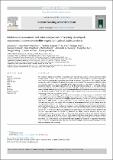Global-scale assessment and inter-comparison of recently developed/reprocessed microwave satellite vegetation optical depth products
Author(s)
Li, Xiaojun; Wigneron, Jean-Pierre; Frappart, Frédéric; Fan, Lei; Ciais, Philippe; Fensholt, Rasmus; Entekhabi, Dara; Brandt, Martin; Konings, Alexandra G; Liu, Xiangzhuo; Wang, Mengjia; Al-Yaari, Amen; Moisy, Christophe; ... Show more Show less
DownloadAccepted version (34.70Mb)
Publisher with Creative Commons License
Publisher with Creative Commons License
Creative Commons Attribution
Terms of use
Metadata
Show full item recordAbstract
The vegetation optical depth (VOD), a vegetation index retrieved from passive or active microwave remote sensing systems, is related to the intensity of microwave extinction effects within the vegetation canopy layer. This index is only marginally impacted by effects from atmosphere, clouds and sun illumination, and thus increasingly used for ecological applications at large scales. Newly released VOD products show different abilities in monitoring vegetation features, depending on the algorithm used and the satellite frequency. VOD is increasingly sensitive to the upper vegetation layer as the frequency increases (from L-, C- to X-band), offering different capacities to monitor seasonal changes of the leafy and/or woody vegetation components, vegetation water status and aboveground biomass. This study evaluated nine recently developed/reprocessed VOD products from the AMSR2, SMOS and SMAP space-borne instruments for monitoring structural vegetation features related to phenology, height and aboveground biomass. For monitoring the seasonality of green vegetation (herbaceous and woody foliage), we found that X-VOD products, particularly from the LPDR-retrieval algorithm, outperformed the other VOD products in regions that are not densely vegetated, where they showed higher temporal correlation values with optical vegetation indices (VIs). However, LPDR X-VOD time series failed to detect changes in VOD after rainfall events whereas most other VOD products could do so, and overall daily variations are less pronounced in LPDR X-VOD. Results show that the reprocessed VODCA C- and X-VOD have almost comparable performance and VODCA C-VOD correlates better with VIs than other C-VOD products. Low frequency L-VOD, particularly the new version (V2) of SMOS-IC, show a higher temporal correlation with VIs, similar to C-VOD, in medium-densely vegetated biomes such as savannas (R ~ 0.70) than for other short vegetation types. Because the L-VOD indices are more sensitive to the non-green vegetation components (trunks and branches) than higher frequency products, they are well-correlated with aboveground biomass: (R ~ 0.91) across space between predicted and observed values for both SMOS-IC V2 and SMAP MT-DCA. However, when compared with forest canopy height, results at L-band are not systematically better than C- and X-VOD products. This revealed specific VOD retrieval issues for some ecosystems, e.g., boreal regions. It is expected that these findings can contribute to algorithm refinements, product enhancements and further developing the use of VOD for monitoring above-ground vegetation biomass, vegetation dynamics and phenology.
Date issued
2020-12Department
Massachusetts Institute of Technology. Department of Civil and Environmental EngineeringJournal
Remote Sensing of Environment
Publisher
Elsevier BV
Citation
Xiaojun Li, Jean-Pierre Wigneron, Frédéric Frappart, Lei Fan, Philippe Ciais, Rasmus Fensholt, Dara Entekhabi, Martin Brandt, Alexandra G. Konings, Xiangzhuo Liu, Mengjia Wang, Amen Al-Yaari, Christophe Moisy,
Global-scale assessment and inter-comparison of recently developed/reprocessed microwave satellite vegetation optical depth products, Remote Sensing of Environment, Volume 253, 2021 © 2020 Elsevier Inc.
Version: Author's final manuscript
ISSN
0034-4257